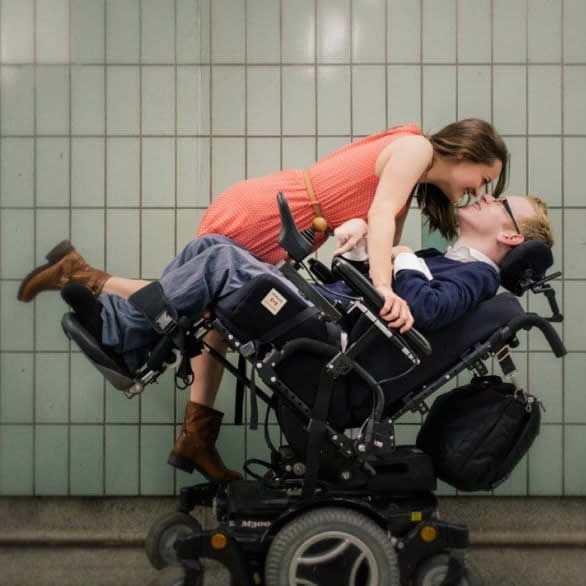Intersectionality between disability and sex - Gemma P.


Description:
My artifact shows two people who are engaging in a romantic and intimate pose. One person appears to be physically disabled in a wheelchair wearing dark and dull clothing, whilst the other appears to be abled bodied wearing bold and bright clothing.
Significance:
I chose this artifact because it’s a good representation on disability and sexuality as it shows that people who have a disability still have sexual desires and impulses just like any abled person.
The artifact shows that people who have a disability are not a-sexual and do in fact have sexual desires and impulses. Society shape’s and form’s stigma and stereotypes against disabled people from “ableist assumptions” such as who gets sexual education, what is classified as sexy in popular culture and what are the normative ways of “moving, feeling, seeing and hearing” (Silverberg, 2011). These assumptions that society have can place a negative impact and result in disabled people getting less of an experience, education, and acceptance towards sex (Silverberg, 2011).
Society looks upon people with a disability as to lack the capabilities to experience love, intimacy, and sexual desires as well as the “agency to be loved” (Liddiard, K. 2021 p. 39). This artifact helps to understand the importance of social justice and the inclusion of people with disabilities within a modern society (Shuttleworth, R. 2007 p.1). This can include what degree the disabled individuals’ sensations are such as moving, hearing, seeing and talking, which can impact how they are viewed in society as “sexual subjects” which they can be referred to as “asexual or hypersexual” (Shuttleworth, R. 2007 p. 4). This can generate a poor sexual self-esteem towards the person with a disability. Through choosing this artefact helps to highlight the stigma and stereotypes between abled and disabled bodies.
Positionality:
I am interested in disability and sex because you never learn about the two topics combined. I think it is important for social workers and health workers to be aware of these two topics as it can often be uncomfortable and confronting to talk about and discuss with clients and people in general. I am also interested in disability and sex as it challenges social norms and discusses the stigma and stereotypes around people with a disability engaging in sex or feeling sexy. Being a future social worker, it will be common for me to advocate for client’s who may experience inequality surrounding these issues and challenge social norms and stereotypes through using practices such as the circles of sexuality and a sex positive approach. Through learning about disability and sexuality will limit feelings of “discomfort and creating barriers towards clients” (Josefsson, K. A 2019).
The circles of sexuality is a strengths based perspective that has five different areas including “Sensuality, Intimacy, Identity, Reproduction, and Sexualization” (Turner 2020 p. 311). The circles of sexuality help to focus more on human sexuality and helps to understand the prevalence of each circle within a client’s life (Turner 2020 p.313). Through incorporating the circles of sexuality and sex positive approach can prevent sexual shame and negativity when working with a client with a disability in the future (Turner 2020 p. 315).
My interest in disability and sex stems from wanting to ensure people who have a disability can have open conversations with a judgement free approach (Turner 2020 p. 315).
Impact:
This subject has impacted me by allowing me to think and express my views and opinions in a safe environment. It has allowed me to challenge social norms and stereotypes and reflect on what, how and why certain things we have learnt about make me feel uncomfortable. This class has also allowed me to learn how to safely express my thoughts and feelings and start to talk about uncomfortable and personal topics such as sex, that I was always taught as a young girl not to talk about openly, so once again challenging my personal values.
This project has allowed me to grow as a student who’s goal is to be a trained and professional social worker who will have to handle situations around disability and sex. Through stepping out of my comfort zone I learnt how to have conversations around what is deemed as “uncomfortable topics” and how to have a non- bias perspective of disability and sexuality.
This project has also allowed me to reflect on my own vales, beliefs and morals and understand what has shaped and impacted my personal structures and into who I am today. This included stereotypes I may have come across in relation to disability and sexuality, certain stigmas I had been exposed to and reflect on the knowledge I had prior to starting this subject/project.
Wish List:
I hope my artifact inspires viewers to understand that people who have a disability want to experience sex and should not be labelled as asexual or hypersexual. People who have a disability want to be able to be sexually stimulated and experience sexual pleasures and erotic moments with partners or by themselves as individuals.
I also hope my artifact challenge’s the stigmas and social norms people hold around disability and sexuality by making the reader question what they understood and what has shaped their understanding of the topic and if the artifact had made them uncomfortable in any way to challenge those internal thoughts and beliefs surrounding disability and sex.
I hope my audience also considers the social policy issues surrounding and impacting upon people with a disability such as sexual education not being a “primary concern” (Shuttleworth 2007 p.5), which can result to issues later in life for that person.
Overall, I hope the audience critically thinks about the issues people with a disability face compared to someone who may be able bodied. To think about what barriers disabled people go through to participate in what may seem like normal activities such as sex and masturbation. E.g., For a disabled person to have a sexual experience it may need to be exposed to staff, the agency that client may be a part of, client’s parents etc.
Comments are closed.



One Comment
This is excellent Gemma!
I am so proud of you for being so vulnerable on your reflection. The artifact chosen alongside your reflection is really engaging and effective. Looking at your artifact and reading your reflection, I can honestly say that the discourse around disability and sexuality is very important in our society, and it further denotes how people with disabilities need to be considered regarding access to their sexual health and wellbeing. As stated by Turner, Vernacchio & Satterly 2018, your artifact has empowered me to reflect on my own experiences when working with clients to provide the best service as a future social worker.